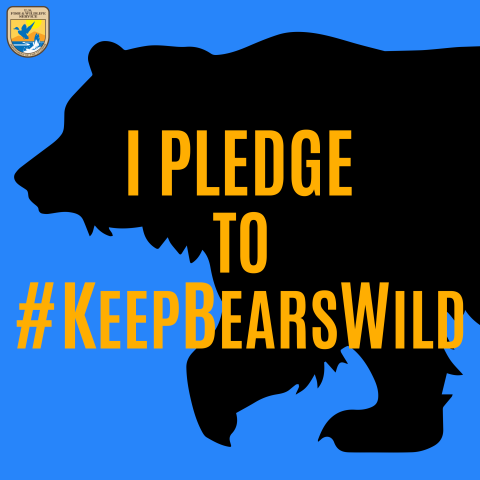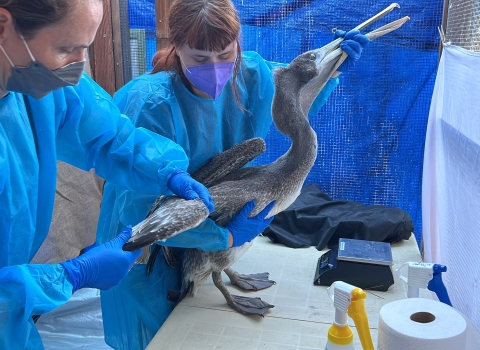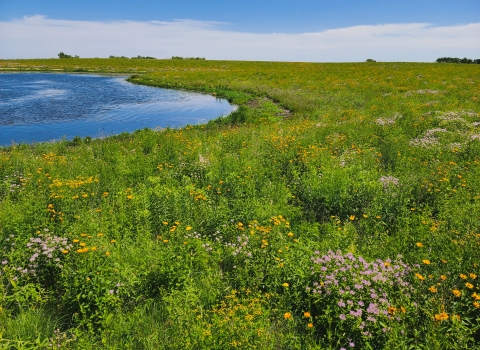DENVER - The U.S. Fish and Wildlife Service (USFWS), the National Park Service (NPS), and other agencies at the request of USFWS have partnered in an intensive effort to ensure the safety of grizzly bear #399 and her four yearlings and to mitigate further human-bear conflict. USFWS also thanks the Teton County Sheriff’s office for their support with public safety efforts.
Late yesterday, an interagency team successfully radio-collared two yearlings of grizzly bear #399 in order to better monitor the bears’ location and take steps to mitigate human-bear conflicts. After collaring, the two yearlings, along with a third that was not collared, were released together in the presence of #399 and the remaining yearling. These steps, including the use of hazing when appropriate, are being taken to prevent the need for further management actions to ensure the safety of the bears and to mitigate further human-bear conflict. In recent days there has been a significant increase in the frequency of the five bears lingering near human residences and accessing human sources of food, including apiculture beehives, unsecured animal feed, and garbage. The most common human-bear conflicts result from unsecured attractants and surprise encounters.
“The Service recognizes the high level of interest in grizzly bear #399, and we thank all of our partners for coming together to do what we can to ensure both the safety of the public as well as the safety of #399 and her yearlings from growing risks of human-bear conflict,” said Acting USFWS Regional Director Matt Hogan. “This preventive step will help us mitigate further conflicts to protect grizzly bear #399, her yearlings, and the public.”
Grizzly bears in the lower-48 states are listed as threatened under the Endangered Species Act (ESA). Management authority for grizzlies in Wyoming rests with the USFWS, working closely with NPS, Wyoming Game and Fish Department, and U.S. Forest Service. Each conflict situation is unique and requires input from staff on the ground, a thorough history of bear interactions and behavior, and close coordination with other federal, Tribal, state, and local agencies.
Even with this intensive interagency effort, residents and visitors have the ability to prevent conflicts and food conditioning from occurring. It is important that bears do not feel comfortable near human-occupied dwellings. If grizzly bear #399, or any other bears, are in a residential area, people can make loud noises, such as yelling or banging pots and pans, to make bears feel uncomfortable and help move them along.
The public can make a difference in a bear’s life by doing its part to ensure bears never obtain food rewards, whether you call the Greater Yellowstone Ecosystem (GYE) home or are just passing through. Residents of local communities are encouraged to secure attractants around their homes and store all garbage within bear-resistant containers. Attractants include items with a scent, such as trash, livestock feed, compost, or beehives. Ensure bird feeders are at least ten feet up, and four feet out from any building. Avoid planting fruit trees. Help your neighbors create a bear-wise community to protect wildlife. It may be cliché; however, more often than not, “a fed bear is a dead bear.” Please do your part to protect bears like #399 and her yearlings, as well as the public.
For more information about keeping yourself and bears safe in bear country, please visit the Wyoming Bear Wise program, Grand Teton NP Staying Safe in Bear County, or the Interagency Grizzly Bear Safety page.
The mission of the U.S. Fish and Wildlife Service is working with others to conserve, protect, and enhance fish, wildlife, plants, and their habitats for the continuing benefit of the American people. For more information on our work and the people who make it happen in the West, connect with us through any of these social media channels: Facebook, Twitter, Flickr, YouTube, and Instagram.



